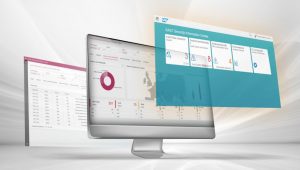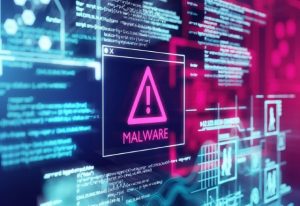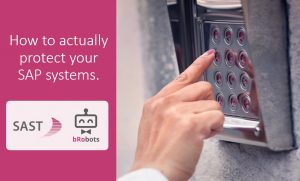 At the DSAG Technology Days in Early May, the Vulnerability Management Working Group renewed its demand for a security dashboard, which SAP announced many years ago. In light of the current threat situation, it is advisable to stop waiting for it, particularly since good solutions from security specialists have become available in the interim, which also optimize the integration of SAP security with the overall enterprise security architecture. When it comes to end-to-end IT security, it is worthwhile to take a look at the operators of critical infrastructure (CIP) and the new German IT Security Act 2.0 (ITSA 2.0).
At the DSAG Technology Days in Early May, the Vulnerability Management Working Group renewed its demand for a security dashboard, which SAP announced many years ago. In light of the current threat situation, it is advisable to stop waiting for it, particularly since good solutions from security specialists have become available in the interim, which also optimize the integration of SAP security with the overall enterprise security architecture. When it comes to end-to-end IT security, it is worthwhile to take a look at the operators of critical infrastructure (CIP) and the new German IT Security Act 2.0 (ITSA 2.0).
SAP Threat Detection
Protect your SAP systems against ransomware attacks with reliable transport analyses
 Transports are an essential part of an SAP environment. They are used to transfer changes from one system to another, to implement new functions, to perform updates, and to install third-party applications. Change management in SAP is inconceivable without transports. Yet how can they be checked for security risks?
Transports are an essential part of an SAP environment. They are used to transfer changes from one system to another, to implement new functions, to perform updates, and to install third-party applications. Change management in SAP is inconceivable without transports. Yet how can they be checked for security risks?
Why are SIEM tools blind to SAP? An interesting question, and not only for operators of critical infrastructure who are migrating to SAP S/4HANA.
 Cybersecurity is a hot topic right now: increasing numbers of external attacks on company networks during the pandemic and the further professionalization of the attackers have made it even more important. In recent months, we’ve been reading about attacks on companies almost every day, which have suffered consequences up to and including total shutdowns that lasted for days. What elements of SAP security have changed, for whom is Germany’s IT Security Act 2.0 relevant, how can you take this account during migration to SAP S/4HANA, and what can every company do to improve SAP security?
Cybersecurity is a hot topic right now: increasing numbers of external attacks on company networks during the pandemic and the further professionalization of the attackers have made it even more important. In recent months, we’ve been reading about attacks on companies almost every day, which have suffered consequences up to and including total shutdowns that lasted for days. What elements of SAP security have changed, for whom is Germany’s IT Security Act 2.0 relevant, how can you take this account during migration to SAP S/4HANA, and what can every company do to improve SAP security?
SAP Cyber Security: Five questions and answers about effectively monitoring SAP systems
 Do companies need a comprehensive security strategy for their SAP systems? The objective should be the integration into the bigger picture. Due to the lack of structures for overall security, however, security measures on a smaller scale are frequently omitted. It is therefore necessary to optimize internal control systems and – particularly for securing SAP systems – and to establish comprehensive monitoring. Learn more open the interplay of point in time and time frame of the security monitoring.
Do companies need a comprehensive security strategy for their SAP systems? The objective should be the integration into the bigger picture. Due to the lack of structures for overall security, however, security measures on a smaller scale are frequently omitted. It is therefore necessary to optimize internal control systems and – particularly for securing SAP systems – and to establish comprehensive monitoring. Learn more open the interplay of point in time and time frame of the security monitoring.
Data Loss Prevention – protect your sensitive data!
 Sensitive enterprise data demands special protection. In addition to company-specific protection requirements, industry-specific specifications and legal regulations must also be observed. Minimizing the risk of losing critical data from SAP systems requires a variety of coordinated measures, collectively known as “data loss prevention”.
Sensitive enterprise data demands special protection. In addition to company-specific protection requirements, industry-specific specifications and legal regulations must also be observed. Minimizing the risk of losing critical data from SAP systems requires a variety of coordinated measures, collectively known as “data loss prevention”.
Knock, knock! What if a hacker has already broken in when your IT auditor is at the door?
 The procedure is well-known at SMEs and large companies: Every year, the auditor comes around for the IT audit, which is carried out as part of the annual overall review. The general objective is to ensure the security and integrity of the audited system (usually the SAP system used for accounting) and to identify potential risks. A management letter then describes follow-up measures to mitigate these risks in future. But does this approach still make sense today?
The procedure is well-known at SMEs and large companies: Every year, the auditor comes around for the IT audit, which is carried out as part of the annual overall review. The general objective is to ensure the security and integrity of the audited system (usually the SAP system used for accounting) and to identify potential risks. A management letter then describes follow-up measures to mitigate these risks in future. But does this approach still make sense today?
Interview with Ralf Kempf and Norbert Klettner – Cybersecurity in logistics: Multinational attacks on the weakest links in the chain
 How should companies in the port and transportation logistics sector tackle cybersecurity? Can smaller and midmarket companies even protect themselves against the growing threats? Our CTO Ralf Kempf and his colleague Norbert Klettner, Managing Director of AKQUINET PORT CONSULTING, were interviewed on this subject by DVZ, a German transportation newspaper.
How should companies in the port and transportation logistics sector tackle cybersecurity? Can smaller and midmarket companies even protect themselves against the growing threats? Our CTO Ralf Kempf and his colleague Norbert Klettner, Managing Director of AKQUINET PORT CONSULTING, were interviewed on this subject by DVZ, a German transportation newspaper.
Security dashboards – Just a buzzword or a true help with the daily security routine?
 Companies that use SAP software, as well as the German-speaking SAP User Group (DSAG), are demanding security dashboards to provide for greater transparency and indicate necessary activities. The most critical risks, however, are those that arise as a combination of other events, which are not critical in and of themselves. After all, even the best dashboards aren’t able to display this kind of unidentified security incident.
Companies that use SAP software, as well as the German-speaking SAP User Group (DSAG), are demanding security dashboards to provide for greater transparency and indicate necessary activities. The most critical risks, however, are those that arise as a combination of other events, which are not critical in and of themselves. After all, even the best dashboards aren’t able to display this kind of unidentified security incident.
Why your SAP security and compliance strategy can’t wait for an SAP S/4HANA migration
 Companies have been sensitized to the risks: According to a recent report by consulting firm Ernst & Young, 97 percent of the surveyed executives expect that they will face an even greater risk of cyberattacks and data leaks in the future. And they also know that they can hardly keep up with the rapid advances. That’s why we recommend that you give thought to end-to-end protection of your SAP systems now – no matter whether you’re still using SAP ERP or have already migrated to SAP S/4HANA. The sooner you start with an end-to-end strategy, the better you’ll protect yourself against threats – both internal and external.
Companies have been sensitized to the risks: According to a recent report by consulting firm Ernst & Young, 97 percent of the surveyed executives expect that they will face an even greater risk of cyberattacks and data leaks in the future. And they also know that they can hardly keep up with the rapid advances. That’s why we recommend that you give thought to end-to-end protection of your SAP systems now – no matter whether you’re still using SAP ERP or have already migrated to SAP S/4HANA. The sooner you start with an end-to-end strategy, the better you’ll protect yourself against threats – both internal and external.
Don’t lose track of the big picture – a security dashboard provides transparency for all your SAP systems
 The lack of SAP security management dashboards is discussed often by the Security & Vulnerability Working Group at DSAG, the German-speaking SAP User Group. The Working Group sees such tools an essential prerequisite for developing and monitoring the improved security concepts that are urgently needed. Yet a majority of companies has yet to implement the dashboard technology although now would be a particularly good time to implement this efficient tool for mitigating attacks in light of the increasing threat level posed by malware and ransomware.
The lack of SAP security management dashboards is discussed often by the Security & Vulnerability Working Group at DSAG, the German-speaking SAP User Group. The Working Group sees such tools an essential prerequisite for developing and monitoring the improved security concepts that are urgently needed. Yet a majority of companies has yet to implement the dashboard technology although now would be a particularly good time to implement this efficient tool for mitigating attacks in light of the increasing threat level posed by malware and ransomware.

